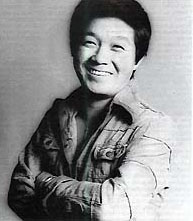Kyu Sakamoto and Japan Airlines Flight 123

Kyu Sakamoto
Kyu Sakamoto (Hisashi Oshima) was the first Japanese artist to have a number one hit in the United States with "Sukiyaki" (original title "Ue o Muite Arukō") in 1963. He was ranked number 18 in a list of Japan's top 100 influential musicians by HMV. Sakamoto (age 43) was a passenger on Japan Airlines Flight 123 (JAL123) when it crashed into a mountain in 1985. The tragedy was the deadliest single-aircraft accident and the second-deadliest aviation accident in history (after the Tenerife disaster). (Thanks to Wikipedia for the information.)
On 12 August 1985, JAL123 left Tokyo International Airport (Haneda Airport) at 6:12 PM with 509 passengers and 15 crew members on board, enroute to the city of Osaka. About 12 minutes after takeoff, the rear pressure bulkhead failed. The resulting explosive decompression tore the vertical stabilizer from the aircraft and severed all four of the aircraft's hydraulic systems. The first photograph, below, shows the vertical stabilizer separating from the plane's fuselage. The second photograph, taken moments later, shows the aircraft with the stabilizer missing.

JAL123 as the vertical stabilizer separates from the plane's fuselage.

JAL123 shown in flight, its vertical stabilizer missing.
The pilots set their transponder to broadcast a distress signal to Tokyo Area Control Center, which directed the aircraft to descend and gave it heading vectors for an emergency landing. Continued control problems required them to first request vectors back to Haneda, then to Yokota (a U.S. military air base), then back to Haneda again as the aircraft wandered uncontrollably.
With the loss of all control surfaces, the aircraft began to oscillate up and down in what is known as a phugoid cycle, a flight mode typical of accidents that disable an aircraft's controls. After descending to 13,500 feet, the pilots reported that the aircraft was uncontrollable. It headed for the Pacific Ocean, then turned back toward the shore and descended to below 7,000 feet before the pilots managed to return to a climb. The aircraft reached an altitude of 13,000 feet before entering a wild descent into the mountains and disappearing from radar at 6:56 p.m. and 6,800 feet. The plane hit a mountain as a result of the loss of control, flipped, and landed on its back. All 15 crew members and 505 of the 509 passengers were killed.
Thirty-two minutes elapsed from the time of the accident to the time of the crash, long enough for some passengers to write farewells to their families. One of these passengers was Kyu Sakamoto.

Kyu Sakamoto's grave in Tokyo.
Official Findings
The official cause of the crash according to Japan's then Aircraft Accidents Investigation Commission is as follows:
1. The aircraft was involved in a tailstrike incident at Osaka International Airport on June 2, 1978, which damaged the aircraft's rear pressure bulkhead.
2. The subsequent repair of the bulkhead did not conform to Boeing's approved repair methods. Boeing's procedures called for one continuous doubler plate with three rows of rivets to reinforce the damaged bulkhead, but the technicians fixing the aircraft used two separate doubler plates, one with two rows of rivets and one with only one row.[11] This reduced the part's resistance to metal fatigue by 70%. According to the FAA, the one "doubler plate" which was specified for the job, (the FAA calls it a "splice plate" - essentially a patch), was cut into two pieces parallel to the stress crack it was intended to reinforce, "to make it fit". This negated the effectiveness of two of the rows of rivets. During the investigation Boeing calculated that this incorrect installation would fail after approximately 10,000 pressurizations; the aircraft accomplished 12,319 take-offs between the installation of the new plate and the final accident.
3. When the bulkhead gave way, the resulting explosive decompression ruptured the lines of all four hydraulic systems. With the aircraft's control surfaces disabled, the aircraft became uncontrollable.

